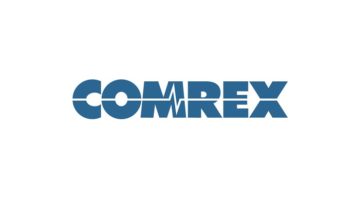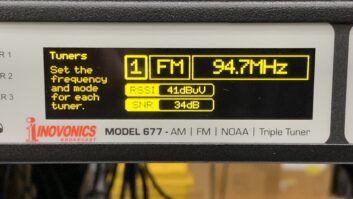
In early 2013, Nautel and Omnia introduced an AES3 composite multiplex implementation that uses only the left channel of a 192 kHz AES3 link. This implementation does not allow the entire 99 kHz composite MPX signal to be digitized into a single bitstream. The Nyquist frequency of 192 kHz is 96 kHz, and practical anti-aliasing filters limit the flat passband to a frequency significantly lower than Nyquist. Hence, any subcarriers above about 80 kHz (in particular, 92 kHz SCAs) must be injected and digitized separately.
We at Orban believe that the main advantages of a digital composite connection are convenience and RFI immunity. Existing analog composite connections are simple and offer excellent audio performance. It is wise to be very skeptical of marketing claims that a digital composite connection provides audibly better sound at the radio unless those claims were verified by bias-controlled, double-blind listening tests per the ITU-R BS.1116 standard (“ABC/HR”), which is intended to detect very small losses of audible transparency in transmission channels. For example, BS.1116 is the “gold standard” for testing high-bitrate lossy codecs designed to be audibly transparent. The “placebo effect” can be very strong when one is doing sighted listening tests, and even expert listeners cannot wish it away or avoid it, regardless of how aware they are of its existence.
COMPOSITE TRANSPORT STANDARDS
For moving composite baseband digitally, we believe that using AES3 hardware makes a lot of sense because AES3 is well-established and has inexpensive, robust support available from several chipmakers. However, because of the bandwidth issue, we see the current implementation as an interim solution that solves only part of the problem of passing the entire FM stereo composite baseband in digital form to the transmitter.
A standards-committee working group, like the NRSC, could have tackled the question of how to use the interface to accommodate subcarriers. We feel that it was unwise for the proponents to have bypassed a standards-setting body, instead presenting the interface as a fait accompli without input from other processor, STL and transmitter manufacturers. We are seeing a similar problem right now with audio-over-IP, whose universal adoption is being slowed by manufacturer-proprietary implementations that preclude universal interoperability, making life much harder on end users than it would be if there were a universally accepted standard like AES3. History has shown that universal interoperability always benefits an entire industry in the end, and Orban would be happy to participate in such a process.
FULL-BANDWIDTH DIGITAL
Orban is in the process of implementing a digital composite output as an available option for Optimod-FM 8600, mainly because we designed this hardware with “hooks” to accommodate a future digital composite standard. In the Omnia/Nautel implementation, the left channel of the AES3 signal is used to pass the FM stereo part of the composite baseband, leaving the right channel available. Orban’s implementation is a backward-compatible superset of a left channel-only system. We believe that our system is a reasonable candidate for standardization because it removes the bandwidth limitation while using the same AES3 192 kHz transport as the original system.
We sample at 384 kHz and multiplex the samples in an even-odd sequence between the left and right channels of a 192 kHz AES3 link. This is equivalent to quadrature sampling at 192 kHz (i.e. sampling a given channel twice at 192 kHz, but with the clock phase shifted by 90 degrees that produces a quadrature output). This produces “I” (in-phase) and “Q” (quadrature) signals on the left and right AES3 channels, respectively, at a 192 kHz sample rate. This system has sufficient bandwidth to pass the entire FM baseband (up to 99 kHz) without aliasing. The link uses straightforward 192 kHz stereo AES hardware, and relies on the fact that the AES3 standard allows the left and right channels to be sample-locked and time-synchronized with each other to prevent both phase cancellation in a mono mixdown and widening of the stereo image.
If the input spectrum is limited to 96 kHz or less, either the I or Q channels can be used alone to reconstruct the signal. This makes the system backward compatible with a system that uses only the I signal on the left channel, like the current Omnia/Nautel implementation. If there is energy above 96 kHz, reconstructing the original 384 kHz signal’s odd and even samples from the left and right channels will cancel aliasing.
We do not specify any special treatment of AES status bits or user bits. The only unusual requirement is that the frequency response of the left and right channels of the link (including sample rate conversion) must remain flat to 96 kHz if the system is required to carry 92 kHz SCAs. Assuming a 92 kHz SCA, the signal will contain energy up to 99 kHz in the original baseband, and alias energy appears between 93 and 96 kHz in the left and right channels of the link. The phase relationship of the aliases in the two channels is such that quadrature resampling at the receiver reconstructs any energy above 96 kHz in the baseband and cancels the 93–96 kHz aliases.
What about sample rate conversion in this system? If we sample-rate-convert the I and Q signals with two identical SRCs, phase-locked together, we do not change either the magnitude or phase of the baseband spectra of the I and Q channels, and these remain locked together in time, although both are delayed an equal amount by the filters in the SRCs. This means that the original baseband (with energy above 96 kHz) can be reconstructed by quadrature resampling after a second sample rate conversion at the receiver that restores the original 192 kHz sample rate. However, the intermediate sample rate must not add further aliasing to the signal and must not truncate energy below 96 kHz. In practice, this means that only upsampling is practical. Moreover, the original sample rate must be restored exactly in order to cancel the aliases after quadrature resampling. Hence, sample rate conversion must be done with considerable care and must be synchronous. For upward conversion, the anti-imaging filter that follows the SRC must be flat to 96 kHz.
These requirements preclude use of commercial asynchronous SRC chips designed for digital audio. Instead, a synchronous SRC should be implemented in DSP so that the designer can ensure that the bandwidth criteria are satisfied. If a polyphase structure is used in the SRC (as is customary because of its computational efficiency), it should be designed to be flat to 96 kHz.
KEEP IT SIMPLE
Because of the complications involved in sample rate conversion, we recommend that the audio path remain at 192 kHz with no sample rate converters inline. The only condition where inline asynchronous SRC is acceptable is if the system is being used in its “downward compatible” mode, where the baseband frequencies must be limited to 96 kHz or less and only the left channel is used. In this case, no aliasing cancellation is required at the receiver, so asynchronous SRC is acceptable.
This system is unlikely to be used to digitize existing analog-only composite signals. However, for completeness, we need to state that a 384 kHz analog to digital converter must have a flat passband to 99 kHz. If a given A/D was originally designed for digital audio, it may have a gentle anti-aliasing filter that is only flat to 20 kHz and rolls off gently thereafter, trading ultrasonic frequency response for low ringing in the time domain. So a designer must make sure to choose a digitizer with a “wideband” mode.
Robert Orban is vice president and chief engineer for Orban Corp.
Comment on this or any article. Write to [email protected] with “Letter to the Editor” in the subject field.












